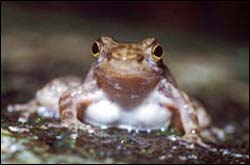Endangered frogs coexist with fungus once thought fatal

Worldwide amphibian declines have reached crisis proportions. In many areas, habitat loss is the likely culprit but, in 1996, it was suggested that some unknown disease had spread through the populations. In 1998, the fungus Batrachochytrium dendrobatidis was identified from sick and dead frogs and, since then, several lines of laboratory based evidence have suggested that B. dendrobatidis is to blame for the dramatic frog declines. But with little information about how the disease impacts frogs in the wild, the causal role of this chytrid fungus remains unclear. In the open access journal PLoS Biology, Australian researchers Richard Retallick, Hamish McCallum and Rick Speare now “show unequivocally” that remaining populations of T. eungellensis, a rainforest frog listed as endangered, can persist in the wild with stable infections of this fungus.
To evaluate the effects of the fungus on frogs in their natural habitat, the authors focused on six species living in the high-elevation rainforest streams of Eungella National Park in Queensland, Australia, where frog losses were “particularly catastrophic”. Two species vanished between 1985 and 1986: the Eungella Gastric-Brooding Frog (Rheobatrachus vitellinus), which is now thought extinct, and the Eungella Torrent Frog (Taudactylus eungellensis), which later reappeared in a few small populations. In the PLoS Biology study, Retallick et al. tested tissue samples taken from frogs between 1994 and 1998 – before the disease had been identified. The marked frogs were released back into the wild at the time the samples were collected. The authors found fungal infections in the samples of two species, including T. eungellensis. An analysis of tissue from recaptured frogs during the same period showed that the prevalence of infection did not vary from year to year, suggesting that the infection is now endemic. McCallum and colleagues also found no evidence that survival differed between infected and uninfected frogs, suggesting that this potentially devastating amphibian disease now coexists with the frogs, with little effect on their populations.
While these findings do not exonerate the fungus as the agent of mass declines, they can rule out the possibility that the fungus caused the decline, then vanished from the area, allowing frog populations to recover. Although it’s possible that B. dendrobatidis did not cause the initial T. eungellensis declines, surviving frog populations may have developed resistance to the pathogen, or less virulent strains of the fungus may have evolved. If it turns out that frog populations can develop resistance to the chytrid fungus, the researchers point out, then a conservation program of captive breeding and selecting for resistance could potentially thwart the extinction of these, and other, critically endangered frogs.
Media Contact
More Information:
http://www.plos.orgAll latest news from the category: Life Sciences and Chemistry
Articles and reports from the Life Sciences and chemistry area deal with applied and basic research into modern biology, chemistry and human medicine.
Valuable information can be found on a range of life sciences fields including bacteriology, biochemistry, bionics, bioinformatics, biophysics, biotechnology, genetics, geobotany, human biology, marine biology, microbiology, molecular biology, cellular biology, zoology, bioinorganic chemistry, microchemistry and environmental chemistry.
Newest articles
Humans vs Machines—Who’s Better at Recognizing Speech?
Are humans or machines better at recognizing speech? A new study shows that in noisy conditions, current automatic speech recognition (ASR) systems achieve remarkable accuracy and sometimes even surpass human…

Not Lost in Translation: AI Increases Sign Language Recognition Accuracy
Additional data can help differentiate subtle gestures, hand positions, facial expressions The Complexity of Sign Languages Sign languages have been developed by nations around the world to fit the local…

Breaking the Ice: Glacier Melting Alters Arctic Fjord Ecosystems
The regions of the Arctic are particularly vulnerable to climate change. However, there is a lack of comprehensive scientific information about the environmental changes there. Researchers from the Helmholtz Center…



